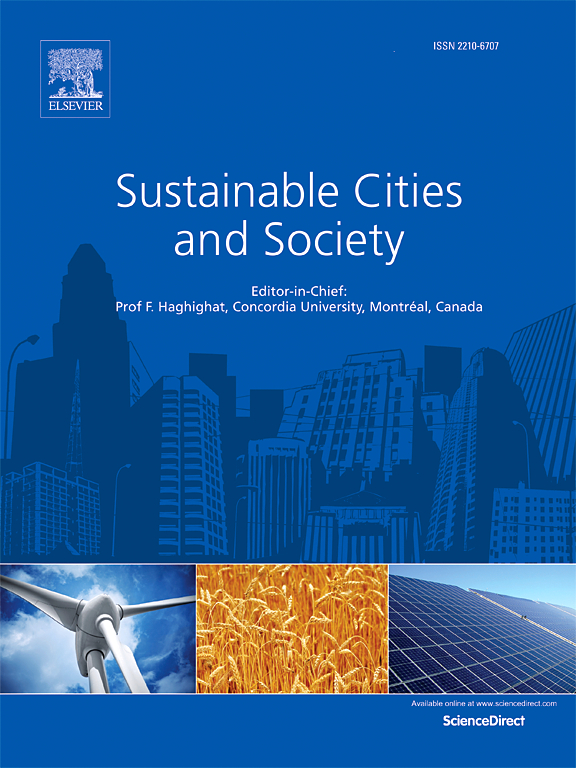细颗粒物成分与高血压住院率之间的个体和混合关联:来自华南大规模队列研究的见解
IF 10.5
1区 工程技术
Q1 CONSTRUCTION & BUILDING TECHNOLOGY
引用次数: 0
摘要
细颗粒物(PM2.5)污染威胁着城市的可持续发展。很少有队列研究对与PM2.5成分的滞后和累积暴露相关的高血压风险进行评估。利用华南地区 36271 人的队列研究数据(2015-2020 年),我们通过 Cox 比例危险度回归研究了随时间变化的 PM2.5 和六种成分(NO3-、SO42-、BC、CL-、NH4+ 和 OM)与高血压住院之间的个体关联。使用基于量纲的 g 计算模型,在滞后 0 年、滞后 1 年、滞后 2 年、滞后 0-1 年和滞后 0-2 年分析了同时暴露于这些成分的混合关联。个体效应分析表明,在不同的时间窗口中,CL-、NH4+、SO42-和NO3-每增加一个量级,高血压风险就会增加17%-32%。在不同滞后时间同时暴露于PM2.5成分会增加总体高血压的入院率,危险比(95%置信区间)分别为1.151(1.136-1.166)、1.221(1.205-1.238)、1.257(1.241-1.273)、1.087(1.073-1.101)和1.197(1.182-1.212)。次生水溶性离子(NO3-、SO42-、NH4+、CL-)是主要因素。据观察,45 岁以下人群、男性、教育程度较低、体重不健康或绿地接触有限的人更容易受到影响。这些发现凸显了同时暴露于PM2.5成分对高血压的滞后和累积影响。本文章由计算机程序翻译,如有差异,请以英文原文为准。
Individual and mixed associations between fine particulate matter components and hospital admissions for hypertension: Insights from a large-scale South Chinese cohort study
Fine particulate matter (PM2.5) pollution threatens urban sustainability. Few cohort studies have assessed hypertension risks linked to lagged and cumulative exposure to PM2.5 components. Using data from a cohort study of 36,271 individuals in South China (2015–2020), we examined the individual associations between time-varying PM2.5 and six components (NO3−, SO42−, BC, CL−, NH4+, and OM) with hypertension hospitalization through Cox proportional hazards regression. Mixed associations of simultaneous exposure to these components were analyzed at lag 0, lag 1, lag 2, lag 0–1, and lag 0–2 years using quantile-based g-computation models. Individual-effect analysis revealed strong associations, with each quantile increase in CL−, NH4+, SO42−, and NO3− linked to 17 %–32 % higher hypertension risks across different time windows. Co-exposure to PM2.5 components at different lag times increased hospital admissions for overall hypertension, with hazard ratios (95 % confidence intervals) of 1.151 (1.136–1.166), 1.221 (1.205–1.238), 1.257 (1.241–1.273), 1.087 (1.073–1.101), and 1.197 (1.182–1.212). Secondary water-soluble ions (NO3−, SO42−, NH4+, CL−) were major contributors. Increased susceptibility was observed among those under 45, men, individuals with lower education, unhealthy weight, or limited green space exposure. These findings highlight the lagged and cumulative impacts of simultaneous exposure to PM2.5 component on hypertension.
求助全文
通过发布文献求助,成功后即可免费获取论文全文。
去求助
来源期刊

Sustainable Cities and Society
Social Sciences-Geography, Planning and Development
CiteScore
22.00
自引率
13.70%
发文量
810
审稿时长
27 days
期刊介绍:
Sustainable Cities and Society (SCS) is an international journal that focuses on fundamental and applied research to promote environmentally sustainable and socially resilient cities. The journal welcomes cross-cutting, multi-disciplinary research in various areas, including:
1. Smart cities and resilient environments;
2. Alternative/clean energy sources, energy distribution, distributed energy generation, and energy demand reduction/management;
3. Monitoring and improving air quality in built environment and cities (e.g., healthy built environment and air quality management);
4. Energy efficient, low/zero carbon, and green buildings/communities;
5. Climate change mitigation and adaptation in urban environments;
6. Green infrastructure and BMPs;
7. Environmental Footprint accounting and management;
8. Urban agriculture and forestry;
9. ICT, smart grid and intelligent infrastructure;
10. Urban design/planning, regulations, legislation, certification, economics, and policy;
11. Social aspects, impacts and resiliency of cities;
12. Behavior monitoring, analysis and change within urban communities;
13. Health monitoring and improvement;
14. Nexus issues related to sustainable cities and societies;
15. Smart city governance;
16. Decision Support Systems for trade-off and uncertainty analysis for improved management of cities and society;
17. Big data, machine learning, and artificial intelligence applications and case studies;
18. Critical infrastructure protection, including security, privacy, forensics, and reliability issues of cyber-physical systems.
19. Water footprint reduction and urban water distribution, harvesting, treatment, reuse and management;
20. Waste reduction and recycling;
21. Wastewater collection, treatment and recycling;
22. Smart, clean and healthy transportation systems and infrastructure;
 求助内容:
求助内容: 应助结果提醒方式:
应助结果提醒方式:


